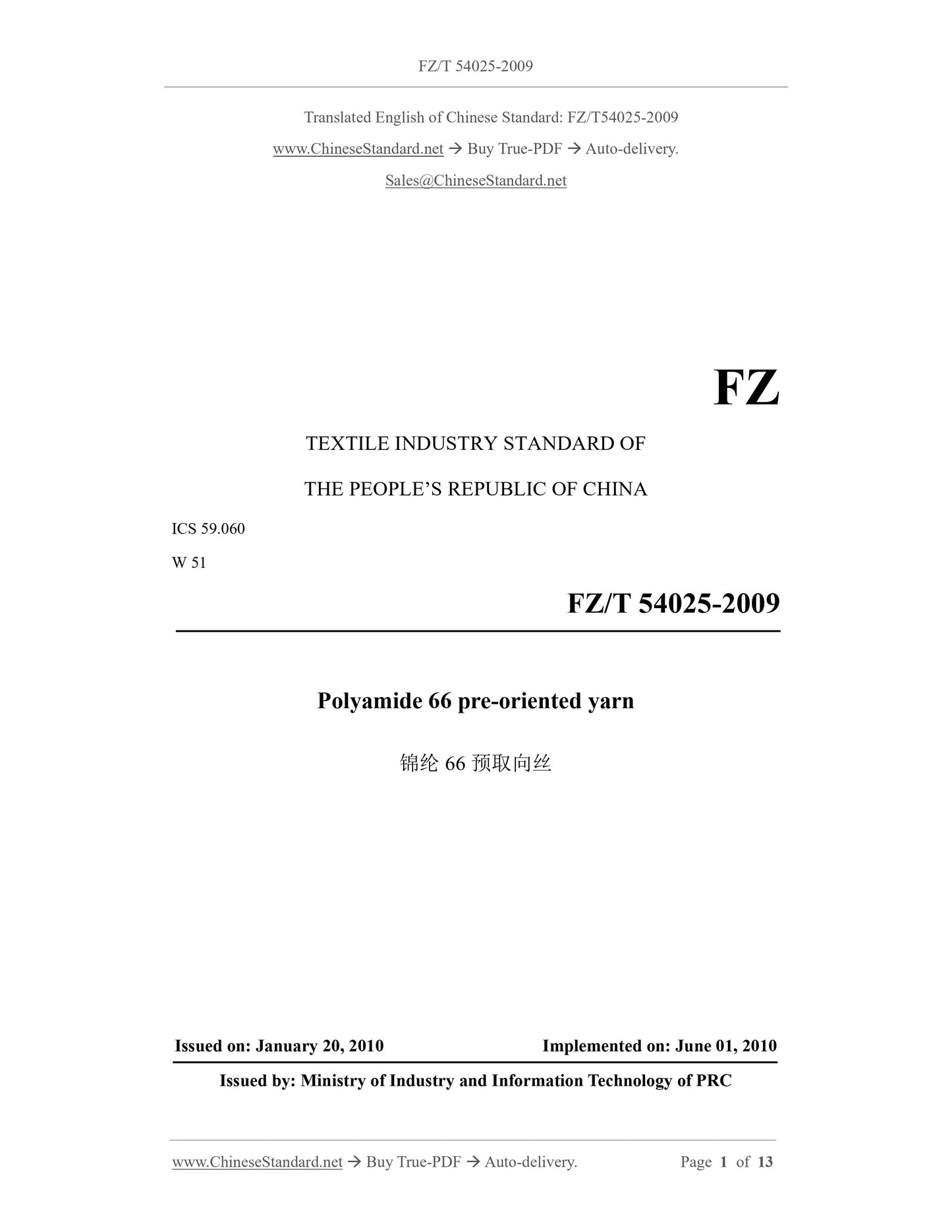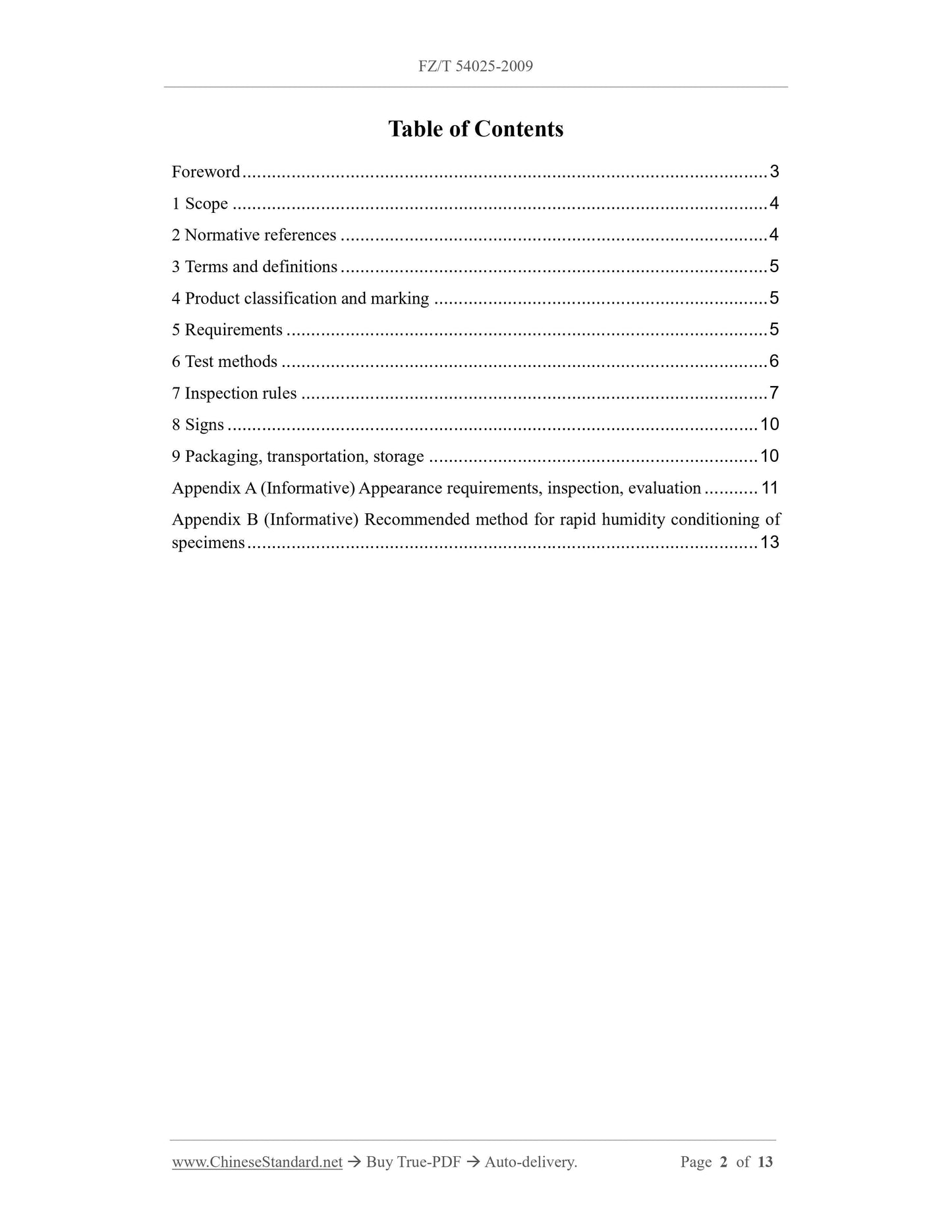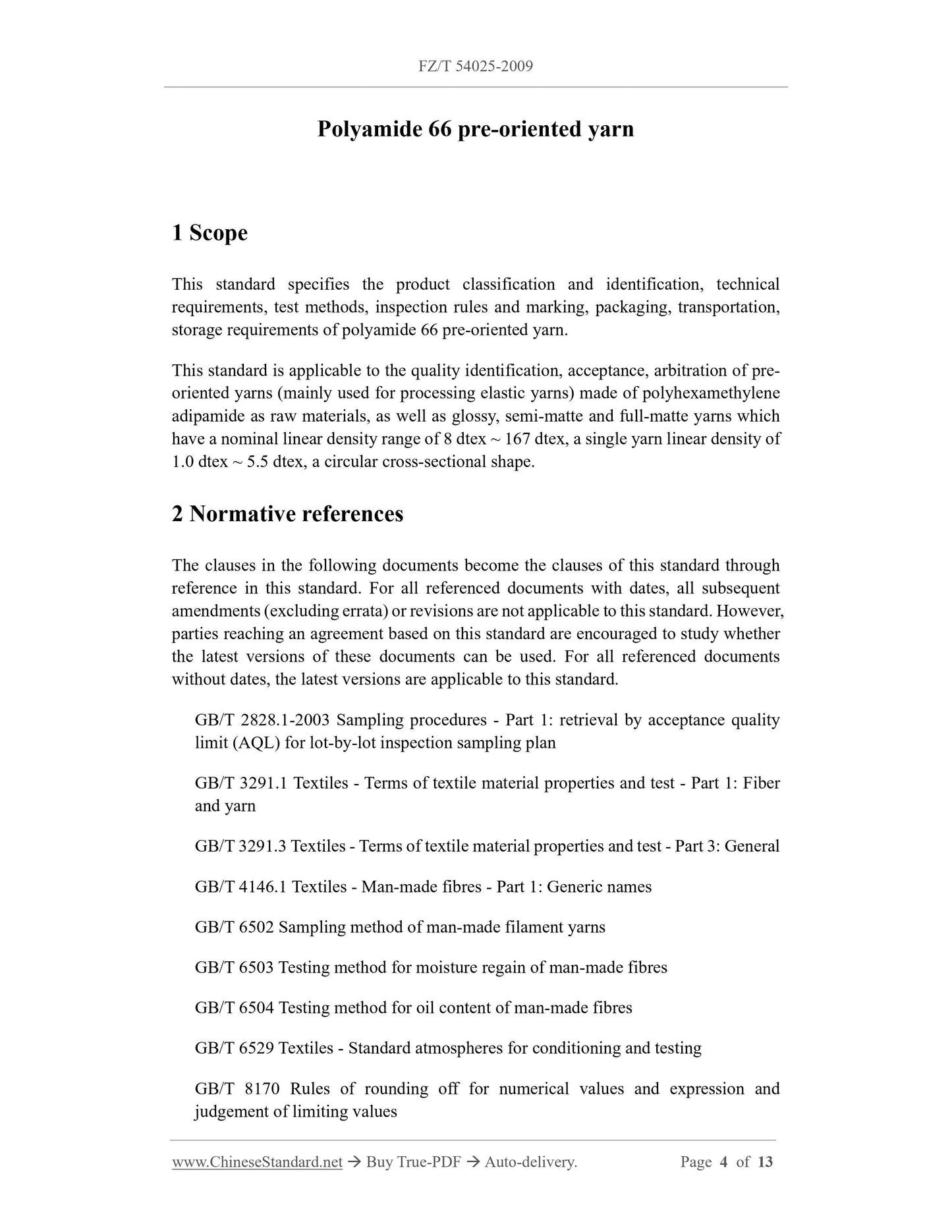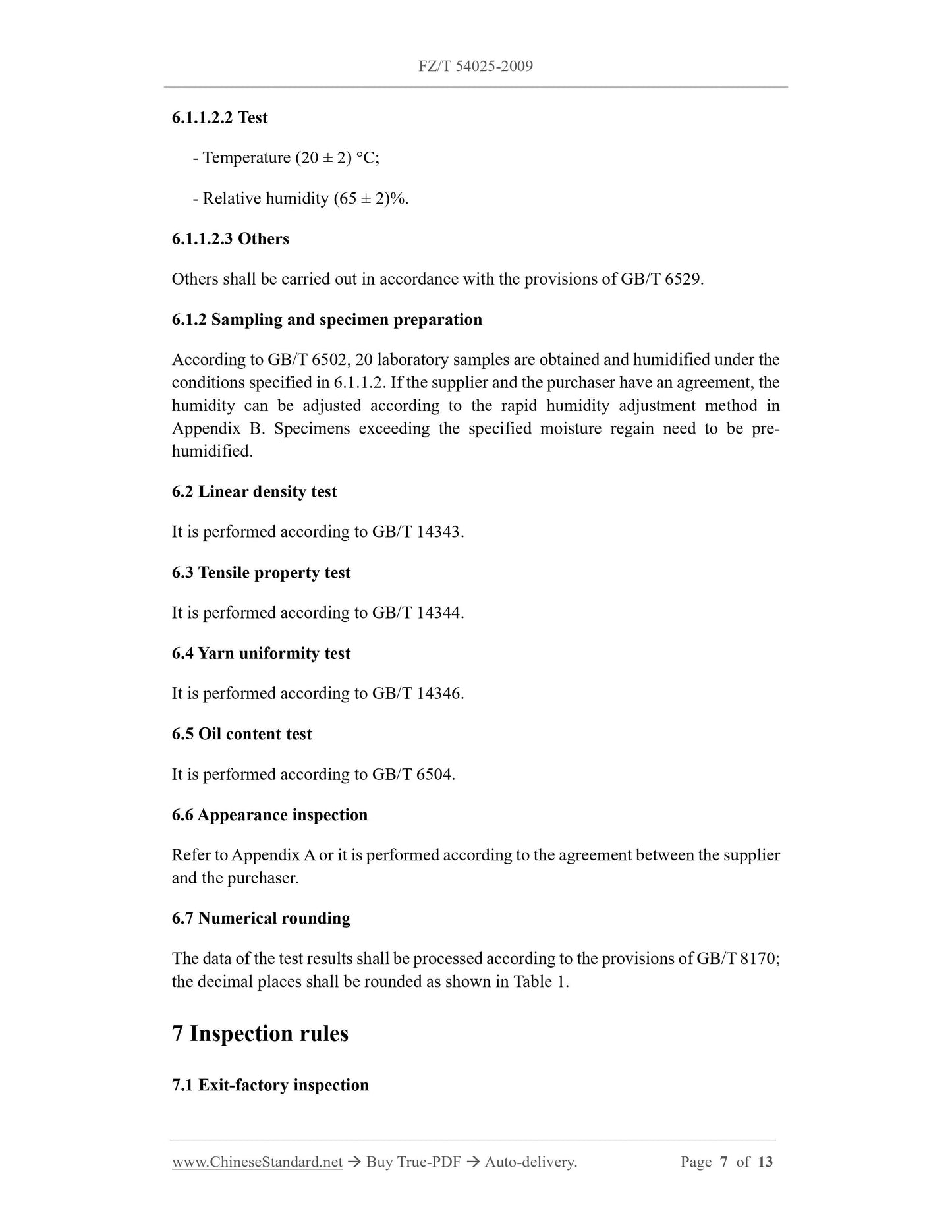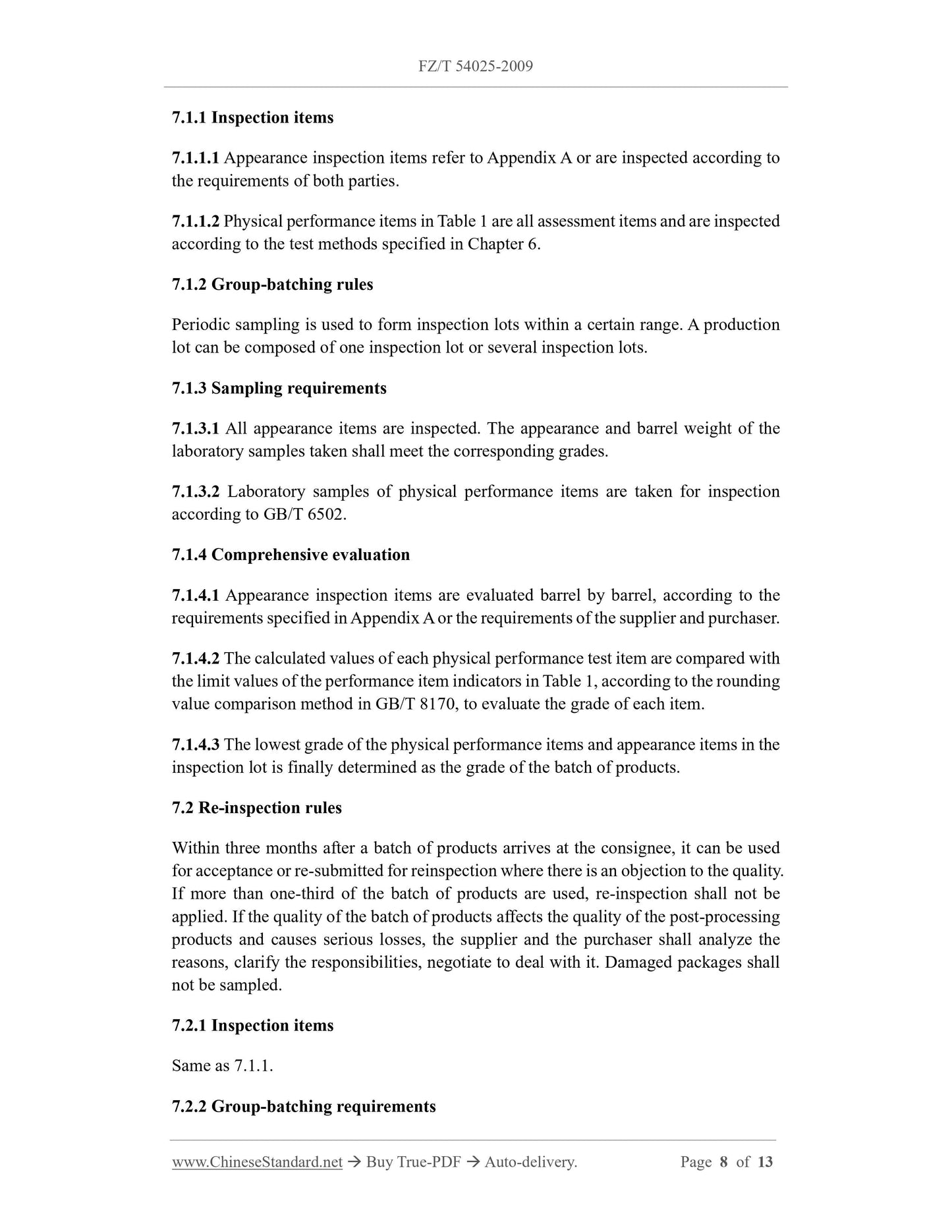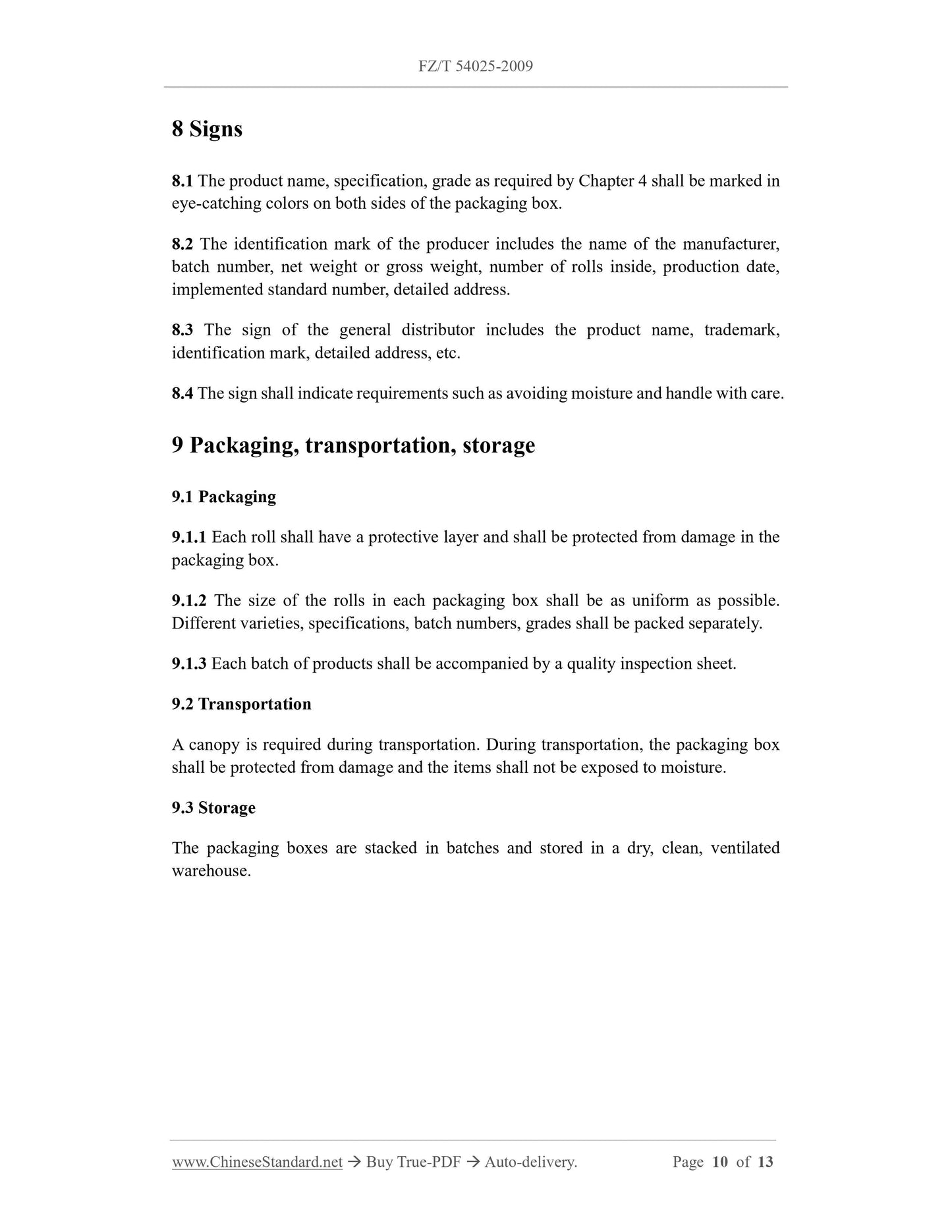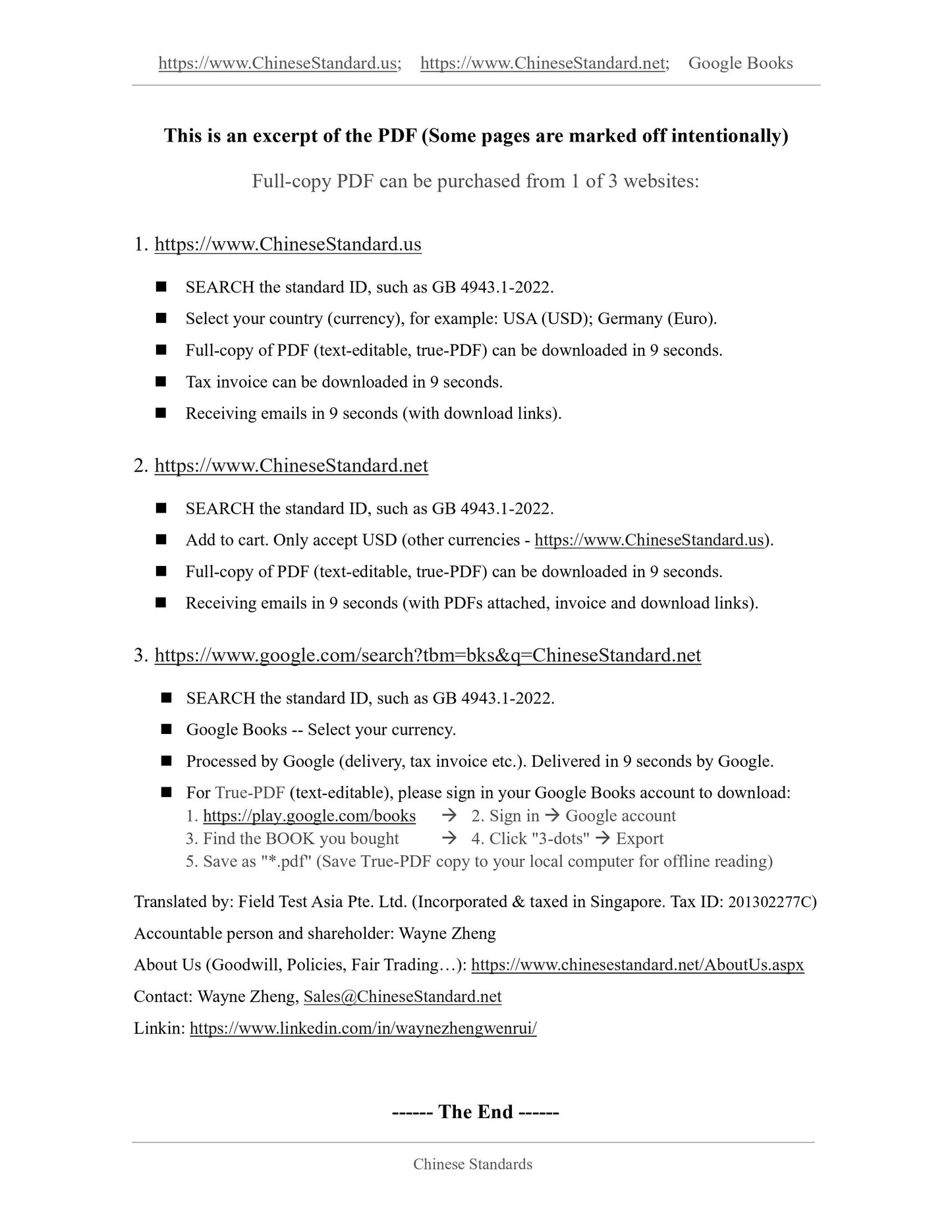1
/
of
7
PayPal, credit cards. Download editable-PDF and invoice in 1 second!
FZ/T 54025-2009 English PDF (FZT54025-2009)
FZ/T 54025-2009 English PDF (FZT54025-2009)
Regular price
$160.00 USD
Regular price
Sale price
$160.00 USD
Unit price
/
per
Shipping calculated at checkout.
Couldn't load pickup availability
Delivery: 3 seconds. Download true-PDF + Invoice.
Get QUOTATION in 1-minute: Click FZ/T 54025-2009
Historical versions: FZ/T 54025-2009
Preview True-PDF (Reload/Scroll if blank)
FZ/T 54025-2009: Polyamide 66 pre-oriented yarn
FZ/T 54025-2009
FZ
TEXTILE INDUSTRY STANDARD OF
THE PEOPLE’S REPUBLIC OF CHINA
ICS 59.060
W 51
Polyamide 66 pre-oriented yarn
锦纶 66预取向丝
ISSUED ON. JANUARY 20, 2010
IMPLEMENTED ON. JUNE 01, 2010
Issued by. Ministry of Industry and Information Technology of PRC
Table of Contents
Foreword... 3
1 Scope... 4
2 Normative references... 4
3 Terms and definitions... 5
4 Product classification and marking... 5
5 Requirements... 5
6 Test methods... 6
7 Inspection rules... 7
8 Signs... 10
9 Packaging, transportation, storage... 10
Appendix A (Informative) Appearance requirements, inspection, evaluation... 11
Appendix B (Informative) Recommended method for rapid humidity conditioning of
specimens... 13
Polyamide 66 pre-oriented yarn
1 Scope
This standard specifies the product classification and identification, technical
requirements, test methods, inspection rules and marking, packaging, transportation,
storage requirements of polyamide 66 pre-oriented yarn.
This standard is applicable to the quality identification, acceptance, arbitration of pre-
oriented yarns (mainly used for processing elastic yarns) made of polyhexamethylene
adipamide as raw materials, as well as glossy, semi-matte and full-matte yarns which
have a nominal linear density range of 8 dtex ~ 167 dtex, a single yarn linear density of
1.0 dtex ~ 5.5 dtex, a circular cross-sectional shape.
2 Normative references
The clauses in the following documents become the clauses of this standard through
reference in this standard. For all referenced documents with dates, all subsequent
amendments (excluding errata) or revisions are not applicable to this standard. However,
parties reaching an agreement based on this standard are encouraged to study whether
the latest versions of these documents can be used. For all referenced documents
without dates, the latest versions are applicable to this standard.
GB/T 2828.1-2003 Sampling procedures - Part 1.retrieval by acceptance quality
limit (AQL) for lot-by-lot inspection sampling plan
GB/T 3291.1 Textiles - Terms of textile material properties and test - Part 1.Fiber
and yarn
GB/T 3291.3 Textiles - Terms of textile material properties and test - Part 3.General
GB/T 4146.1 Textiles - Man-made fibres - Part 1.Generic names
GB/T 6502 Sampling method of man-made filament yarns
GB/T 6503 Testing method for moisture regain of man-made fibres
GB/T 6504 Testing method for oil content of man-made fibres
GB/T 6529 Textiles - Standard atmospheres for conditioning and testing
GB/T 8170 Rules of rounding off for numerical values and expression and
judgement of limiting values
6.1.1.2.2 Test
- Temperature (20 ± 2) °C;
- Relative humidity (65 ± 2)%.
6.1.1.2.3 Others
Others shall be carried out in accordance with the provisions of GB/T 6529.
6.1.2 Sampling and specimen preparation
According to GB/T 6502, 20 laboratory samples are obtained and humidified under the
conditions specified in 6.1.1.2.If the supplier and the purchaser have an agreement, the
humidity can be adjusted according to the rapid humidity adjustment method in
Appendix B. Specimens exceeding the specified moisture regain need to be pre-
humidified.
6.2 Linear density test
It is performed according to GB/T 14343.
6.3 Tensile property test
It is performed according to GB/T 14344.
6.4 Yarn uniformity test
It is performed according to GB/T 14346.
6.5 Oil content test
It is performed according to GB/T 6504.
6.6 Appearance inspection
Refer to Appendix A or it is performed according to the agreement between the supplier
and the purchaser.
6.7 Numerical rounding
The data of the test results shall be processed according to the provisions of GB/T 8170;
the decimal places shall be rounded as shown in Table 1.
7 Inspection rules
7.1 Exit-factory inspection
7.1.1 Inspection items
7.1.1.1 Appearance inspection items refer to Appendix A or are inspected according to
the requirements of both parties.
7.1.1.2 Physical performance items in Table 1 are all assessment items and are inspected
according to the test methods specified in Chapter 6.
7.1.2 Group-batching rules
Periodic sampling is used to form inspection lots within a certain range. A production
lot can be composed of one inspection lot or several inspection lots.
7.1.3 Sampling requirements
7.1.3.1 All appearance items are inspected. The appearance and barrel weight of the
laboratory samples taken shall meet the corresponding grades.
7.1.3.2 Laboratory samples of physical performance items are taken for inspection
according to GB/T 6502.
7.1.4 Comprehensive evaluation
7.1.4.1 Appearance inspection items are evaluated barrel by barrel, according to the
requirements specified in Appendix A or the requirements of the supplier and purchaser.
7.1.4.2 The calculated values of each physical performance test item are compared with
the limit values of the performance item indicators in Table 1, according to the rounding
value comparison method in GB/T 8170, to evaluate the grade of each item.
7.1.4.3 The lowest grade of the physical performance items and appearance items in the
inspection lot is finally determined as the grade of the batch of products.
7.2 Re-inspection rules
Within three months after a batch of products arrives at the consignee, it can be used
for acceptance or re-submitted for reinspection where there is an objection to the quality.
If more than one-third of the batch of products are used, re-inspection shall not be
applied. If the quality of the batch of products affects the quality of the post-processing
products and causes serious losses, the supplier and the purchaser shall analyze the
reasons, clarify the responsibilities, negotiate to deal with it. Damaged packages shall
not be sampled.
7.2.1 Inspection items
Same as 7.1.1.
7.2.2 Group-batching requirements
8 Signs
8.1 The product name, specification, grade as required by Chapter 4 shall be marked in
eye-catching colors on both sides of the packaging box.
8.2 The identification mark of the producer includes the name of the manufacturer,
batch number, net weight or gross weight, number of rolls inside, production date,
implemented standard number, detailed address.
8.3 The sign of the general distributor includes the product name, trademark,
identification mark, detailed address, etc.
8.4 The sign shall indicate requirements such as avoiding moisture and handle with care.
9 Packaging, transportation, storage
9.1 Packaging
9.1.1 Each roll shall have a protective layer and shall be protected from damage in the
packaging box.
9.1.2 The size of the rolls in each packaging box shall be as uniform as possible.
Different varieties, specifications, batch numbers, grades shall be packed separately.
9.1.3 Each batch of products shall be accompanied by a quality inspection sheet.
9.2 Transportation
A canopy is required during transportation. During transportation, the packaging box
shall be protected from damage and the items shall not be exposed to moisture.
9.3 Storage
The packaging boxes are stacked in batches and stored in a dry, clean, ventilated
warehouse.
Get QUOTATION in 1-minute: Click FZ/T 54025-2009
Historical versions: FZ/T 54025-2009
Preview True-PDF (Reload/Scroll if blank)
FZ/T 54025-2009: Polyamide 66 pre-oriented yarn
FZ/T 54025-2009
FZ
TEXTILE INDUSTRY STANDARD OF
THE PEOPLE’S REPUBLIC OF CHINA
ICS 59.060
W 51
Polyamide 66 pre-oriented yarn
锦纶 66预取向丝
ISSUED ON. JANUARY 20, 2010
IMPLEMENTED ON. JUNE 01, 2010
Issued by. Ministry of Industry and Information Technology of PRC
Table of Contents
Foreword... 3
1 Scope... 4
2 Normative references... 4
3 Terms and definitions... 5
4 Product classification and marking... 5
5 Requirements... 5
6 Test methods... 6
7 Inspection rules... 7
8 Signs... 10
9 Packaging, transportation, storage... 10
Appendix A (Informative) Appearance requirements, inspection, evaluation... 11
Appendix B (Informative) Recommended method for rapid humidity conditioning of
specimens... 13
Polyamide 66 pre-oriented yarn
1 Scope
This standard specifies the product classification and identification, technical
requirements, test methods, inspection rules and marking, packaging, transportation,
storage requirements of polyamide 66 pre-oriented yarn.
This standard is applicable to the quality identification, acceptance, arbitration of pre-
oriented yarns (mainly used for processing elastic yarns) made of polyhexamethylene
adipamide as raw materials, as well as glossy, semi-matte and full-matte yarns which
have a nominal linear density range of 8 dtex ~ 167 dtex, a single yarn linear density of
1.0 dtex ~ 5.5 dtex, a circular cross-sectional shape.
2 Normative references
The clauses in the following documents become the clauses of this standard through
reference in this standard. For all referenced documents with dates, all subsequent
amendments (excluding errata) or revisions are not applicable to this standard. However,
parties reaching an agreement based on this standard are encouraged to study whether
the latest versions of these documents can be used. For all referenced documents
without dates, the latest versions are applicable to this standard.
GB/T 2828.1-2003 Sampling procedures - Part 1.retrieval by acceptance quality
limit (AQL) for lot-by-lot inspection sampling plan
GB/T 3291.1 Textiles - Terms of textile material properties and test - Part 1.Fiber
and yarn
GB/T 3291.3 Textiles - Terms of textile material properties and test - Part 3.General
GB/T 4146.1 Textiles - Man-made fibres - Part 1.Generic names
GB/T 6502 Sampling method of man-made filament yarns
GB/T 6503 Testing method for moisture regain of man-made fibres
GB/T 6504 Testing method for oil content of man-made fibres
GB/T 6529 Textiles - Standard atmospheres for conditioning and testing
GB/T 8170 Rules of rounding off for numerical values and expression and
judgement of limiting values
6.1.1.2.2 Test
- Temperature (20 ± 2) °C;
- Relative humidity (65 ± 2)%.
6.1.1.2.3 Others
Others shall be carried out in accordance with the provisions of GB/T 6529.
6.1.2 Sampling and specimen preparation
According to GB/T 6502, 20 laboratory samples are obtained and humidified under the
conditions specified in 6.1.1.2.If the supplier and the purchaser have an agreement, the
humidity can be adjusted according to the rapid humidity adjustment method in
Appendix B. Specimens exceeding the specified moisture regain need to be pre-
humidified.
6.2 Linear density test
It is performed according to GB/T 14343.
6.3 Tensile property test
It is performed according to GB/T 14344.
6.4 Yarn uniformity test
It is performed according to GB/T 14346.
6.5 Oil content test
It is performed according to GB/T 6504.
6.6 Appearance inspection
Refer to Appendix A or it is performed according to the agreement between the supplier
and the purchaser.
6.7 Numerical rounding
The data of the test results shall be processed according to the provisions of GB/T 8170;
the decimal places shall be rounded as shown in Table 1.
7 Inspection rules
7.1 Exit-factory inspection
7.1.1 Inspection items
7.1.1.1 Appearance inspection items refer to Appendix A or are inspected according to
the requirements of both parties.
7.1.1.2 Physical performance items in Table 1 are all assessment items and are inspected
according to the test methods specified in Chapter 6.
7.1.2 Group-batching rules
Periodic sampling is used to form inspection lots within a certain range. A production
lot can be composed of one inspection lot or several inspection lots.
7.1.3 Sampling requirements
7.1.3.1 All appearance items are inspected. The appearance and barrel weight of the
laboratory samples taken shall meet the corresponding grades.
7.1.3.2 Laboratory samples of physical performance items are taken for inspection
according to GB/T 6502.
7.1.4 Comprehensive evaluation
7.1.4.1 Appearance inspection items are evaluated barrel by barrel, according to the
requirements specified in Appendix A or the requirements of the supplier and purchaser.
7.1.4.2 The calculated values of each physical performance test item are compared with
the limit values of the performance item indicators in Table 1, according to the rounding
value comparison method in GB/T 8170, to evaluate the grade of each item.
7.1.4.3 The lowest grade of the physical performance items and appearance items in the
inspection lot is finally determined as the grade of the batch of products.
7.2 Re-inspection rules
Within three months after a batch of products arrives at the consignee, it can be used
for acceptance or re-submitted for reinspection where there is an objection to the quality.
If more than one-third of the batch of products are used, re-inspection shall not be
applied. If the quality of the batch of products affects the quality of the post-processing
products and causes serious losses, the supplier and the purchaser shall analyze the
reasons, clarify the responsibilities, negotiate to deal with it. Damaged packages shall
not be sampled.
7.2.1 Inspection items
Same as 7.1.1.
7.2.2 Group-batching requirements
8 Signs
8.1 The product name, specification, grade as required by Chapter 4 shall be marked in
eye-catching colors on both sides of the packaging box.
8.2 The identification mark of the producer includes the name of the manufacturer,
batch number, net weight or gross weight, number of rolls inside, production date,
implemented standard number, detailed address.
8.3 The sign of the general distributor includes the product name, trademark,
identification mark, detailed address, etc.
8.4 The sign shall indicate requirements such as avoiding moisture and handle with care.
9 Packaging, transportation, storage
9.1 Packaging
9.1.1 Each roll shall have a protective layer and shall be protected from damage in the
packaging box.
9.1.2 The size of the rolls in each packaging box shall be as uniform as possible.
Different varieties, specifications, batch numbers, grades shall be packed separately.
9.1.3 Each batch of products shall be accompanied by a quality inspection sheet.
9.2 Transportation
A canopy is required during transportation. During transportation, the packaging box
shall be protected from damage and the items shall not be exposed to moisture.
9.3 Storage
The packaging boxes are stacked in batches and stored in a dry, clean, ventilated
warehouse.
Share
